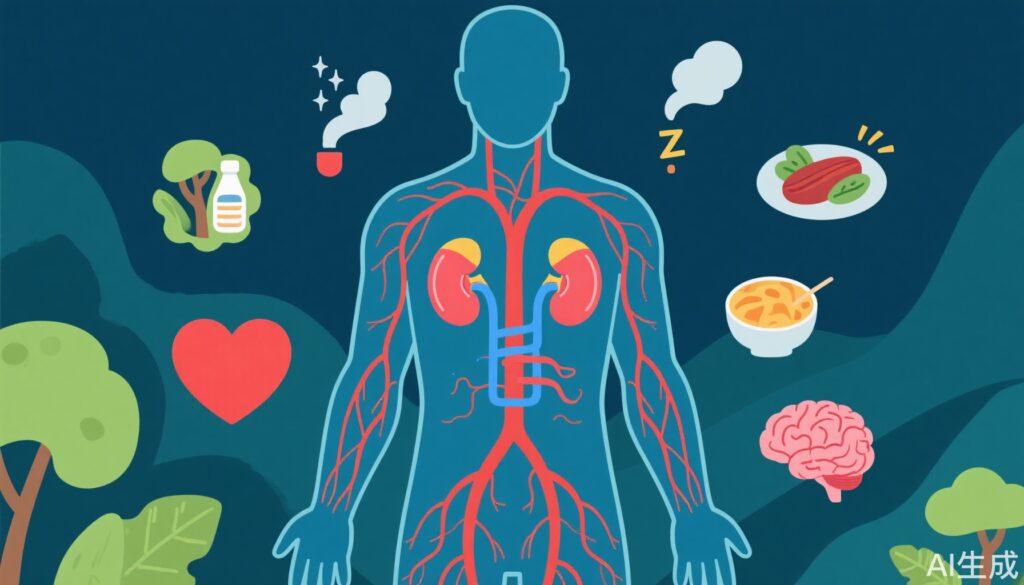Highlights
- Primary hypertension is shaped by complex interactions between renal and nonrenal factors, including genetics, epigenetics, vascular biology, immune responses, and environmental exposures.
- The classic kidney-centered model, focused on sodium regulation and pressure-natriuresis, remains important but is insufficient to explain the full spectrum of hypertension pathogenesis.
- Integrative models are needed for effective prevention, diagnosis, and management of hypertension in diverse populations.
Study Background and Disease Burden
Hypertension remains the leading modifiable risk factor for cardiovascular morbidity and mortality worldwide, affecting more than 1.2 billion adults. Traditional understanding has centered on the kidney’s role, particularly in sodium handling and long-term blood pressure regulation via the pressure-natriuresis mechanism. However, despite advances in renal pathophysiology and the success of renal-targeted therapies, a significant proportion of hypertension cases remain refractory to standard interventions. This observation, coupled with rising global prevalence and heterogeneity in clinical presentations, underscores an unmet need to revisit the origins of primary hypertension and explore a more holistic pathophysiological framework.
Study Design
The referenced article by Vogt et al. (Hypertension. 2025 Aug 5) is a comprehensive critical review synthesizing evidence from epidemiological studies, mechanistic research, and genetic analyses. The authors examine the relative contributions of renal and nonrenal factors to the pathogenesis of primary hypertension, leveraging data from monogenic and polygenic studies, environmental and lifestyle research, and emerging insights from vascular biology and immunology. The review does not present original interventional or observational trial data but offers a state-of-the-art synthesis relevant to clinicians and researchers.
Key Findings
1. The Renal Paradigm—Still Foundational, but Incomplete
The kidney’s central role in blood pressure regulation is well-established, particularly through sodium excretion and the pressure-natriuresis relationship. Reduced nephron endowment, whether due to adverse intrauterine environments or early postnatal stressors, is associated with increased lifetime hypertension risk. Clinical and experimental evidence continues to support the relevance of sodium regulatory pathways, with disturbances leading to salt-sensitive hypertension.
2. Genetic and Epigenetic Complexity
Monogenic hypertension syndromes (e.g., Liddle’s syndrome, glucocorticoid-remediable aldosteronism) have elucidated key renal sodium transport mechanisms, but account for only a small fraction of cases. Polygenic risk scores, aggregating hundreds of loci, reveal that many hypertension-associated variants are located outside genes directly linked to renal function, implicating vascular, neuroendocrine, and immune pathways. Epigenetic modifications—heritable but reversible DNA methylation, histone modification, and non-coding RNA expression—can alter endothelial phenotype in response to environmental triggers, offering a plausible mechanism for gene-environment interplay in hypertension.
3. Vascular and Immune Contributions
Vascular tone regulation, microvascular rarefaction (loss of small blood vessels), and arterial stiffness are increasingly recognized as both contributors and early markers of hypertension. Age-related arterial stiffening, exacerbated by oxidative stress and low-grade inflammation, may precede overt hypertension and influence blood pressure phenotypes in older adults. Interactions with the innate and adaptive immune system—particularly T-cell activation and cytokine signaling—have been shown to modulate both vascular and renal function, further complicating the pathophysiological landscape.
4. The Exposome and Lifestyle Factors
Nonrenal environmental exposures (the “exposome”), such as air pollution, chronic noise, and psychosocial stress, have been implicated in the development of hypertension, sometimes even before conception through epigenetic inheritance. Maternal and paternal health, as well as periconceptional exposures, can influence offspring blood pressure trajectories. Lifestyle choices—high sodium and alcohol intake, tobacco use, physical inactivity—alter sympathetic nervous system activity and vascular reactivity, independently contributing to hypertension risk.
5. Integrative View—Towards Precision Medicine
The cumulative evidence suggests that a kidney-centric model, while valuable, is insufficient for the prevention and management of hypertension. A multifactorial model, integrating renal, vascular, neuroendocrine, immune, genetic, and environmental factors, is necessary to address the complex, individualized nature of hypertension. Such an approach is essential for precision medicine, enabling risk stratification, targeted prevention, and personalized therapeutic strategies.
Expert Commentary
Leading hypertension researchers increasingly advocate for abandoning the exclusive kidney-centered perspective in favor of integrative models. The 2023 European Society of Hypertension guidelines, for instance, highlight the need to assess vascular, metabolic, and inflammatory contributors alongside traditional renal factors. However, challenges remain: the translation of genetic and epigenetic findings to clinical practice is still evolving, and environmental interventions are difficult to implement on a population level. Importantly, the heterogeneity of hypertension phenotypes demands flexible, individualized clinical pathways, rather than a one-size-fits-all approach.
Conclusion
Primary hypertension is a complex, multifactorial disease involving dynamic interactions between renal and nonrenal systems. While the kidney remains central to our understanding, an integrative approach—encompassing genetics, vascular biology, immune responses, and environmental exposures—is essential for advancing prevention and management. Future research should focus on unraveling these interactions and translating mechanistic insights into effective, personalized interventions to curb the global hypertension epidemic.
References
1. Vogt L, Cunha V, Dominiczak AF, Grassi G, Rajzer M, Virdis A, Weber T. Is It Time to Abandon the Kidney-Centered View on the Origin of Primary Hypertension? Hypertension. 2025 Aug 5. doi: 10.1161/HYPERTENSIONAHA.125.24002. Epub ahead of print. PMID: 40762065.
2. Williams B, Mancia G, Spiering W, et al. 2018 ESC/ESH Guidelines for the management of arterial hypertension. Eur Heart J. 2018;39(33):3021-3104.
3. Padmanabhan S, Dominiczak AF. Genomics of hypertension: the road to precision medicine. Nat Rev Cardiol. 2021;18(4):235-250.



